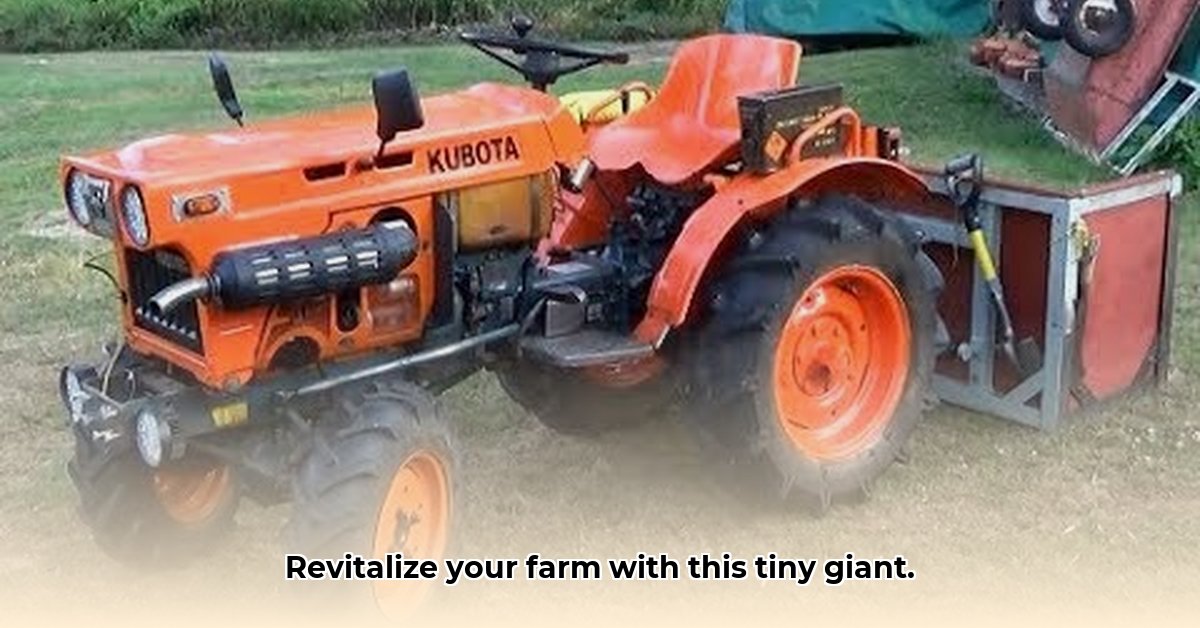
Finding the perfect tractor for your sustainable farm can feel overwhelming. But a used Kubota tractor might be the perfect, budget-friendly solution. This guide shows you how to use a small, older Kubota to achieve your sustainable farming goals. We'll cover everything from finding the right tractor and maintaining it to using it for various sustainable farming tasks. Real-world examples and step-by-step instructions will empower you to make the most of your Kubota. For more information on Kubota tractors, check out this helpful resource: Kubota Tractor Info.
Finding the Right Small Old Kubota Tractor
Choosing a tractor is like choosing the right tool for a specific job. Consider your farm's size, the work you’ll do, and your budget. For smaller spaces, a model like a B7100 or B1700 might suffice. Larger plots or more demanding tasks may call for a higher horsepower model. Remember, a well-maintained older tractor often offers better value than a brand new one; it’s about finding the optimal balance of capability and affordability.
Getting Your Small Old Kubota Tractor Ready to Roll
Before you begin, give your Kubota a thorough inspection. This prevents costly repairs down the road.
- Engine Check: Listen for unusual noises or leaks. Ensure it starts and runs smoothly.
- Fluid Check: Top off engine oil, coolant, and hydraulic fluid (refer to your owner's manual).
- Hydraulic System Check: Inspect for leaks. Test the lift mechanism and three-point hitch.
- Electrical System Check: Test lights, starter motor, and other electrical components.
- Safety Check: Inspect brakes, PTO, and safety switches. Prioritize safety!
Sustainable Farming with Your Small Old Kubota Tractor
A small, used Kubota is surprisingly versatile for sustainable farming:
- Tilling: Efficiently prepare seedbeds, especially beneficial for smaller plots.
- Precision Planting: Attach appropriate implements for precise planting and minimal waste.
- Weed Control: Cultivation reduces water use and herbicide reliance.
- Harvesting: Many small implements are compatible, making harvesting easier.
- Transportation: Easily move supplies and harvested goods, saving you time and labor. This is especially useful for smaller farms where efficiency is key.
Keeping Your Small Old Kubota Tractor in Top Shape
Regular maintenance is key to longevity. Preventative maintenance is far easier (and cheaper!) than emergency repairs.
- Oil Changes: Follow the recommended schedule in your owner's manual.
- Filter Replacements: Replace air, fuel, and hydraulic filters as needed.
- Lubrication: Regularly lubricate moving parts to reduce wear and tear.
- Tire Care: Inflate tires properly and check for damage.
- Seasonal Storage: Properly winterize your tractor to protect it from the elements. This is particularly important for older models that may be more vulnerable to corrosion.
Weighing the Pros and Cons of a Small Old Kubota Tractor
As with any purchase, there's a trade-off.
| Pros | Cons |
|---|---|
| Lower purchase price | May lack advanced features |
| Good fuel economy | Parts sourcing might be slightly more challenging |
| Reliable and durable | May require more frequent maintenance |
| Maneuverable in tight spaces | Lower resale value |
| Lower running costs | Potential for higher repair costs |
Choosing the Right Implements for Your Kubota
Selecting the right implements is crucial. Consider your needs and ensure compatibility with your tractor's PTO and three-point hitch. A tiller, mower, cultivator, and small trailer are all common and useful choices, depending on the size and type of your farming operation.
A Farmer’s Success Story: John and His Kubota
John, a successful organic farmer, attributes his success to his used Kubota. Its reliability, ease of maintenance, and suitability for his operation have been game-changers. This highlights the viability of older, well-maintained tractors in sustainable farming.
How to Finance a Used Sub-40hp Tractor for Sustainable Farming
Securing financing for a used tractor is achievable through several avenues.
- Personal Loans: Flexible, but requires good credit.
- Dealer Financing: May be available, but often focuses on newer models.
- USDA Loans: Offers programs for farmers, but with eligibility requirements.
- Local Banks/Credit Unions: Consider local options for personalized service.
Securing Financing: A Step-by-Step Guide
- Budgeting: Determine your realistic monthly affordability, including maintenance and fuel.
- Researching Loan Options: Compare interest rates and repayment terms.
- Pre-Approval: Get pre-approved to know your borrowing capacity.
- Tractor Inspection: Conduct a thorough inspection by a qualified mechanic.
- Securing the Loan: Complete the necessary paperwork once you find a suitable tractor.
Pros and Cons of Financing Options
| Financing Option | Pros | Cons |
|---|---|---|
| Personal Loans | Flexible, potentially lower rates with good credit | Requires good credit, potentially higher rates with less-than-stellar credit |
| Dealer Financing | Convenient, potential bundling with maintenance | Often higher interest rates, may only apply to newer equipment |
| USDA Loans | Government-backed, potentially lower interest rates | Complex application process, stringent eligibility criteria |
| Local Banks/Credit Unions | Personalized service, potentially flexible repayment terms | Rates vary, might require extensive documentation |
Remember, choosing a fuel-efficient, smaller tractor reduces your carbon footprint and overall long-term costs. A used Kubota can be a valuable asset in building a thriving and sustainable farm.